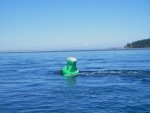joefish
New member
- Joined
- Oct 27, 2009
- Messages
- 157
- Reaction score
- 0
- C Dory Year
- 2011
- C Dory Model
- 25 Cruiser
- Vessel Name
- My Girl
I thought I understood tides pretty well. For years I've paid close attention to tides for fishing and almost always know the tide predictions before I launch a boat. But when I started checking out www.saltwatertides.com for Washington State, Admiralty Inlet, Marrowstone Point, December 5th it did not seem to make sense.
Water height at low tide: 0.8 ft
high tide: 9.4 ft
next low tide: 4.6 ft
next high tide: 5.8 ft
How can there possibly be such extreme differences in hi and low tides in the same day!?!
:shock:
Water height at low tide: 0.8 ft
high tide: 9.4 ft
next low tide: 4.6 ft
next high tide: 5.8 ft
How can there possibly be such extreme differences in hi and low tides in the same day!?!
:shock:

